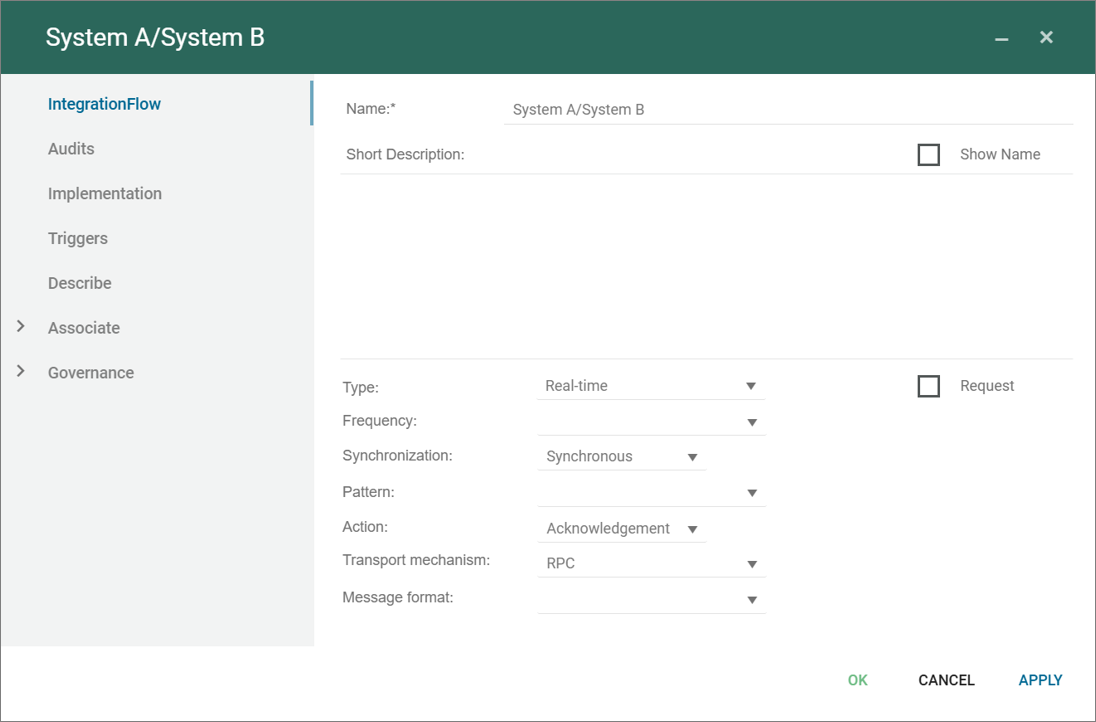In a diagram, an Intellectual Capital Asset symbol represents the intangible assets owned by a company that contribute to its overall value, such as patents, trademarks, copyrights, and trade secrets. These assets are not physical in nature but are valuable because they represent knowledge, expertise, and innovation that can help a company gain a competitive advantage in the market. Intellectual capital assets are critical for organizations to protect, manage, and leverage to maximize their value and potential.
Archives: Templates
Templates and model types in the QualiWare platform.
Integration Flow
This connection describes an integration flow between two systems.

Instantiated Class
An Instantiated Class, in the context of a Class Diagram, refers to a class that has been instantiated, meaning one or more objects have been created based on that class definition. An instantiated class is simply a class for which instances (objects) exist in the system. Instantiated classes are important for understanding how the defined classes in a system are utilized to create real-world objects with their own attributes and behaviors.
Example: In a Class Diagram for a system that manages a university’s courses and students, you might have a class called “Student” with attributes like “studentId”, “name”, and “major”. When the system creates an object representing a specific student, such as “studentId: 12345”, “name: ‘Alice'”, and “major: ‘Computer Science'”, this object is an instance of the “Student” class. The “Student” class is considered an instantiated class because it has been used to create an object in the system.
Instance Value
Description of this template will be available soon.
Instance Specification
An Instance Specification is a template in a Class Diagram that represents an individual instance of a class or a specific occurrence of an object in the system. Instance Specifications are used to provide concrete examples of how objects of a particular class might look like with specific values assigned to their attributes. They can be helpful for illustrating the behavior of the system in specific scenarios or for testing purposes.
Example: In a Class Diagram for a system that manages customer orders, you might have a class called “Order” with attributes like “orderId”, “customerName”, and “orderTotal”. To demonstrate how an instance of the “Order” class would look like, you can create an Instance Specification with specific values for these attributes, such as “orderId: 1001”, “customerName: ‘John Doe'”, and “orderTotal: 150.50”. This instance represents a particular occurrence of an order in the system with the given attribute values.
Input Pin
Defines input data for an activity.
Input Data:DMN
In Decision Model and Notation (DMN), the “Input Data” symbol is used to represent the source of data that will be used in the decision-making process. An Input Data element is a representation of an external data source, which may be a database, a spreadsheet, a file, or any other type of system that provides data for the decision model.
The Input Data symbol is represented as a rectangular box with rounded corners. The name of the Input Data element is usually placed inside the box. The Input Data element is connected to other elements in the decision model using arrows that indicate the flow of data.
Innovation
In an innovation canvas, the symbol “Innovation” typically refers to a new and creative idea or concept that can potentially bring about significant improvements in a particular area or industry. The symbol is often used to represent the overall goal or objective of the innovation process, which is to generate, develop and implement new ideas that can provide competitive advantages, create value, and meet the needs of customers or other stakeholders. The innovation symbol can be used in various ways in an innovation canvas, depending on the specific approach or methodology being used. It may be used to represent a particular product or service, a new business model, a process improvement, a technological advancement, or any other type of innovation.
Initiative
An initiative is a planned project or program that is undertaken by an organization to achieve a specific goal. Initiative is a deliberate effort to bring about a desired change or improvement in the organization. This can range from a small, one-time project to a large, ongoing effort that spans multiple departments or units within the organization.
Initial Node
The starting point of the activity flow. It’s where the flow begins and is represented by a filled black circle.